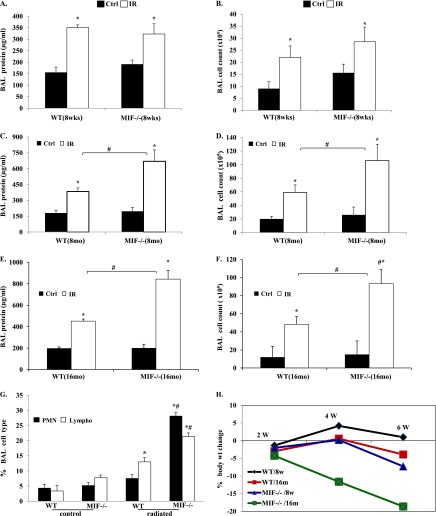Figure 1.
Migration inhibition factor knockout (mif−/−) mice demonstrate age-dependent increased susceptibility to radiation-induced lung injury (RILI). mif−/− and wild-type (WT) control (Ctrl) mice, aged 8 weeks, 8 months, and 16 months, received single-dose 20 Gy radiation to the thorax, and bronchoalveolar lavage (BAL) fluid was collected 6 weeks afterward. Compared with control mice, RILI-challenged 8-week-old WT and mif−/− mice exhibited a significant increase in BAL protein and total cell counts. However, no difference was evident between irradiated (IR) WT and mif−/− mice (A and B). Notably, 8-month-old and 16-month-old mif−/− mice demonstrated significant increases in BAL fluid protein and cell counts, compared with irradiated WT mice (C–G, n = 8/group). *P < 0.05, compared with respective uninjured control mice. #P < 0.05, compared with respective irradiated control mice. Notably, macrophages represented the dominant cell type (> 75%) in both groups of aged (16-mo-old) mice, although a significant increase was evident in the percentage of BAL neutrophils (15–20%), and lymphocytes (Lympho) (10%) in aged mif−/− mice after radiation, compared with irradiated, aged WT animals. (H) Weight change during the period of 6 weeks after radiation. Weight gain in both control, nonirradiated groups were comparable, whereas aged mif−/− mice exhibited significant weight loss after radiation, compared with aged WT mice. W, weeks.

